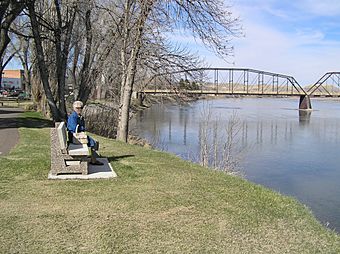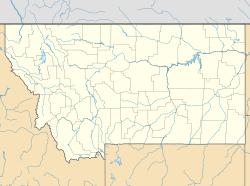Fort Benton Historic District facts for kids
|
Fort Benton Historic District
|
|

View of the Fort Benton Bridge and waterfront
|
|
| Location | Front Street, levee and bridge on the Missouri River, Fort Benton, Montana |
|---|---|
| Area | 20.2 acres (8.2 ha) |
| NRHP reference No. | 66000431 |
Quick facts for kids Significant dates |
|
| Added to NRHP | October 15, 1966 |
| Designated NHLD | November 5, 1961 |
The Fort Benton Historic District is a special area in Fort Benton, Montana. It's recognized as a National Historic Landmark, which means it's a very important place in American history. This district covers the old waterfront parts of the city.
Fort Benton started as a place for trading animal furs. It was built right where big boats could no longer travel up the Missouri River. Before railroads, it was one of the biggest inland ports in the country. This made it super important for growing the American and Canadian West. Today, the Front Street and waterfront area still show signs of this amazing history. This historic district was officially recognized in 1961.
Contents
Fort Benton Historic District
Fort Benton played a huge role in the development of the American West. It was a bustling hub for trade and travel.
A Busy River Port
Fort Benton was once known as "the world's innermost port." This is because it was over 3,000 miles from the ocean by river! It was a key stopping point for goods and people heading west.
The Start of Fort Benton
Fort Benton was founded between 1846 and 1848. A fur trader named Alexander Culbertson started it. He worked for a company that traded furs. The fort was named after Senator Thomas Hart Benton. At first, it was just a simple fort with a wooden fence around it. Inside were buildings for the fur trading business.
Steamboats and Trade
In the early days, goods moved on the river using boats pulled by people or animals. But in 1859, steamboats started coming to Fort Benton. These big boats could carry a lot more goods. They traveled all the way from St. Louis, Missouri. From 1860 to 1890, Fort Benton was a main place for supplies. These supplies helped build up the American West. Goods also went north from here into Canada. This helped cities like Edmonton, Alberta grow.
Why Fort Benton Was Important
The riverfront was a very busy place. Goods were loaded and unloaded on the levee, which is a raised bank along the river. Merchants who managed the trade had their shops on Front Street. Their homes were often nearby. This area was the heart of the city's trade.
The End of the River Era
By the late 1800s, the river trade started to slow down. Railroads became a much faster and more reliable way to move goods. This changed how people and supplies traveled across the country.
Exploring the Historic District
The Fort Benton Historic District stretches along Front Street. It includes the river levee and the old Fort Benton Bridge. This bridge was built in 1888. Local merchants hoped it would help keep the city important as steamboat trade declined.
Old Buildings to See
The district has many old buildings that tell its story. You can find the site of the original Fort Benton. An old blockhouse from 1856 is still there. The levee, built in 1860, is also part of the district. The Grand Union Hotel was built in 1882. It was a grand place for travelers. The Fort Benton Engine House was a fire station. It also served as the city hall for many years. The I.G. Baker House was built in 1867. It is the oldest home still standing in the district.



